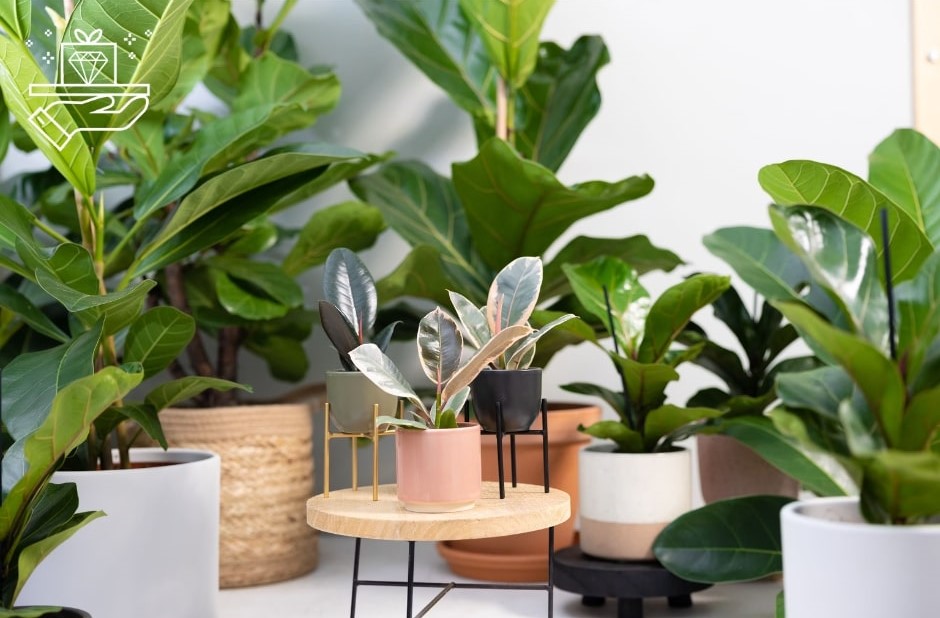Ficus trees are popular indoor plants for a lot of reasons, including their captivating foliage and the fact that they come in different shapes and sizes.
If you’re thinking of picking up a ficus of your own (or giving someone the gift of one!), you’re on the right page. In this article, we’ll reveal the finest ficus tree selections you can choose.
Ficus Plants in a Nutshell


Ficus plants, often referred to as “fig trees,” belong to the Moraceae family and originate from various regions around the world, including Asia, Africa, and the Americas.
They can be small, like a table decoration, or really big, like – well, like a small tree. They also have branches that can bend in interesting ways, giving them an added point of aesthetic interest.
The leaves typically have a glossy texture and the majority of them release yellow or white latex when they are broken. A good number of these plants have aerial roots and a few are epiphytic, which means they can live on other plants.
Why choose ficus plants?


Ficus trees offer more than just aesthetics when chosen as indoor companions. Here’s why they are an excellent choice:
- Aesthetic Appeal: Ficus plants come in a wide array of shapes, sizes, and leaf patterns, which makes them an excellent choice for enhancing the visual appeal of your home.
From delicate, weeping varieties to robust, tree-like forms, there’s a ficus plant to suit every taste.
- Air Purification: According to the NASA Clean Air Study, these plants, particularly Ficus elastica and Ficus benjamina, are natural air purifiers.
They absorb harmful pollutants from the air, such as formaldehyde and benzene, while releasing oxygen. This not only creates a healthier indoor environment but also promotes a sense of well-being.
- Low Maintenance: Ficus plants are relatively low-maintenance, which makes them perfect for both beginners and experienced plant parents. With proper care, they can thrive for many years and add a touch of nature to your home.
- Versatile Placement: Whether you have limited space or a spacious room to fill, ficus plants can adapt to various conditions. Some varieties are well-suited for small spaces, while others can grow into impressive indoor trees.
- Feng Shui Benefits: In Feng Shui, ficus plants are believed to bring positive energy and prosperity to a space. Placing a ficus plant strategically can help create a harmonious and balanced atmosphere in your home.
For example, placing them at the entrance or foyer brings in positive energy and good fortune. Positioning them in a southeast area is also thought to enhance financial prosperity and growth.
10 Types of Ficus Plants Worth Getting
Now that we’ve discussed why ficus plants are a great choice, let’s take a look at 10 different types of ficus plants that are especially popular. You’ll also learn how to care for them:
Weeping Fig


Botanical Name: Ficus benjamina
Origin: Native to India and Northern Australia
Size: Up to 6 feet tall indoors
Light: Bright, indirect light
Water: Water about once a week; allow the soil to dry in between waterings
Toxicity: Toxic to humans and pets
The weeping fig or Ficus benjamina is the official plant of Bangkok, Thailand and is a popular choice for office decor. These plants are usually trained to have braided stems or trunks, topped with a fluttery foliage that resembles a pom-pom.
When using Ficus benjamina in floral arrangements, you can strategically place it towards the outer parts of the arrangement to create a cascading effect with its elegant, drooping leaves.
Its compact size allows you to experiment with different placements to maximize its visual impact, which makes it a versatile choice for various arrangement sizes and designs.
The weeping fig is generally easy to take care of, by the way. Just ensure it gets at least 6 hours of filtered sunlight daily, maintain temperatures between 65-75°F and humidity levels between 60-80%.
Best for: The weeping fig is ideal for those seeking an easy-to-grow indoor plant that adds a touch of elegance to their home.
Chinese Banyan


Botanical Name: Ficus microcarpa
Origin: Native to Southeast Asia, Islands of the Western Pacific, and Australia
Size: Typically 1-2 feet tall when grown indoors
Light: Bright, indirect light
Water: Water once every other week; allow the soil to dry out completely before watering
Toxicity: Toxic to humans and pets
The Ficus microcarpa is known by different names, including Chinese banyan, Indian laurel, Malayan banyan, and curtain fig. This tree bears whitish-red berries and is frequently cultivated in a miniature form, popularly known as the bonsai tree.
This type of ficus plant stands out with its small, dark green leaves and unique aerial roots. These roots can enhance minimalist arrangements and infuse classic styles with elegance.
When including it in your arrangements, consider its size and growth pattern. You can use its roots to create cascading effects by allowing them to gracefully drape over the edges of containers or floral structures.
The plant also pairs wonderfully with complementary flowers like orchids, bromeliads, and anthuriums, as well as foliage such as dracaena, pothos, and ferns. We recommend using it in large-scale arrangements, centerpieces, or botanical-themed designs.
Note that it thrives in bright, indirect sunlight, but can tolerate some shade too. Maintain temperatures between 60-70°F and water when the soil has completely dried out.
Best for: The Chinese banyan is ideal for indoor gardeners looking for a versatile plant that complements both contemporary and traditional designs.
Fiddle-Leaf Fig


Botanical Name: Ficus lyrata
Origin: Native to Africa
Size: Can grow up to 10 feet tall indoors
Light: Bright, indirect light
Water: Keep soil evenly moist at all times; about 2-3 times per week
Toxicity: Toxic to humans and pets
The fiddle-leaf fig is perhaps the most popular ficus plant that’s grown indoors. These trees feature slender, brown trunks and large, glossy leaves shaped like fiddles that broaden at both their bases and tips.
They can grow as tall as 50 feet in the wild, but when nurtured indoors, they typically reach a height of about 10 feet. When used for floral arrangements, you can use Ficus lyrata as a centerpiece to attract attention and elevate overall aesthetics.
It is best to keep this plant’s soil evenly moist and water twice or thrice every week with regular misting to help maintain humidity.
Best for: The fiddle-leaf fig is best for interior design enthusiasts seeking a statement piece that adds a luxurious touch to their space.
Mistletoe Fig


Botanical Name: Ficus deltoidea
Origin: Southeast Asia
Size: Compact, up to 3 feet tall
Light: Full sun, with at least 6 hours of direct sunlight daily
Water: Water every 7 to 10 days; make sure the soil dries out between watering sessions
Toxicity: Toxic to pets and humans
The mistletoe fig, scientifically known as Ficus deltoidea, is native to Southeastern Asia and boasts bright-green, rounded leaves and can grow as a tree or a shrub with a climbing habit in its natural environment.
This ficus produces reddish-white berries when exposed to ample sunlight. These berries make this ficus plant look like mistletoe, hence the name.
This type of ficus plant thrives in full sun with at least 6 hours of direct sunlight daily.
Keep temperatures above 55°F and water approximately every 7 to 10 days, when the soil dries out.
Best for: The mistletoe fig is perfect for plant enthusiasts who like the feel of Christmas in their indoor space even before the holidays come.
Burgundy Rubber Tree


Botanical Name: Ficus elastica ‘Burgundy’
Origin: South America and India
Size: Can reach up to 13 feet when grown indoors
Light: Bright, indirect light
Water: Once a week; allow the soil to dry between waterings
Toxicity: Toxic to humans and pets
The burgundy rubber tree is a cultivar of the Ficus elastica and originates from the lush rainforests of South America and India. It has large, glossy, deep-green, oval-shaped leaves with a center vein painted in a vibrant red or burgundy color.
While this plant is generally low-maintenance, it’s worth noting that it can be sensitive to changes in its surroundings.
This ficus plant flourishes in bright, indirect sunlight, and prefers temperatures ranging from 65-78°F. Its growth rate is approximately 6 inches per year indoors and potentially reaches heights of up to 13 feet.
Best for: The burgundy rubber tree is perfect for individuals interested in a striking, compact houseplant with large, deep-green leaves featuring eye-catching red or burgundy veins.
Creeping Fig


Botanical Name: Ficus pumila
Origin: East Asia
Size: Up to 10-15 feet when grown indoors
Light: Bright, indirect light to partial shade
Water: Weekly; with moist, well-draining soil
Toxicity: Toxic to humans and pets
The creeping fig, scientifically referred to as Ficus pumila, originates from Eastern Asia and is a vine with a trailing and climbing nature. This ficus plant can cling to the walls of your home, and removing it can even damage the paint on your walls!
Still, it has its virtues. It has heart-shaped leaves that create a dynamic and cascading effect in floral designs. The creeping fig is generally easy to care for and needs 6 to 8 hours of bright filtered sunlight and partial shade.
It flourishes in temperatures ranging from 65-85°F and appreciates humidity levels of 50% or higher. It prefers well-draining soil that’s consistently moist with weekly watering.
It has a growth rate of 1 to 2 feet per year, potentially reaching heights of up to 10 to 15 feet when grown indoors.
Best for: The creeping fig is ideal for individuals who enjoy the cascading beauty of trailing vines with small heart-shaped leaves.
Rubber Tree


Botanical Name: Ficus elastica
Origin: Southeast Asia
Size: Can grow up to 6-10 feet tall when grown indoors
Light: Medium to bright, indirect light
Water: Once a week; allow the top inch of the soil to dry between each watering sessions
Toxicity: Toxic to humans and pets
While there are multiple cultivars of the Ficus elastica, the original rubber tree is one of the most popular houseplants. It has a slender, brown trunk from which broad, glossy, ovate leaves in different shades of green appear in an alternating fashion around the stem.
In its natural habitat in the wild, this ficus species can grow nearly 100 feet tall. However, when grown indoors, it maintains a more manageable height of up to 10 feet.
There are many ways to use Ficus elastica, whether as a singular centerpiece or clustered for enhanced effect. You can also pair it with complementary flowers like birds of paradise along with contrasting textures such as ferns to create a visually dynamic and captivating arrangement.
Rubber trees are generally easy to care for and they prefer temperatures between 60-75°F.
Best for: The ficus elastica is best for those looking to enhance their interior with a hardy, elegant plant featuring large, glossy leaves.
Variegated Rubber Tree


Botanical Name: Ficus elastica ‘Ruby’
Origin: Native to the tropical regions of India and Malaysia
Size: Can reach up to 13 feet indoors
Light: 6 to 8 hours of bright, indirect light
Water: Once every one to two weeks
Toxicity: Toxic to humans and pets
The variegated rubber tree, also known as the ruby rubber tree, features broad, large leaves with splashes of cream, green, and a vivid pink or red color. While this rubber tree is very attractive, it’s worth noting that it requires more sunlight compared to other rubber tree varieties.
This is because its less-green leaves are not as efficient at photosynthesis. Despite this, the variegated rubber tree is generally easy to care for.
It requires 6 to 8 hours of bright, indirect sunlight and prefers temperatures ranging from 65-78°F. Water them typically around once every one to two weeks, and regular leaf misting can also be beneficial to them.
The variegated rubber tree grows at an approximate rate of 1 foot per year, and can reach heights of up to about 13 feet when grown indoors.
Best for: The variegated rubber tree is perfect for people who want a visually striking ficus with cream, green, and pink or red leaves.
Rubber Tree


Botanical Name: Ficus elastica ‘Robusta’
Origin: Southeast Asia
Size: Can grow up to 7 feet tall when grown indoors
Light: Bright, indirect light but can also tolerate lower light
Water: About once a week, when the top inch of the soil has dried
Toxicity: Toxic to pets and humans
This particular cultivar of the Ficus elastica has a more compact form and broader leaves. It is known for being easy to care for and prefers bright, indirect light but can also tolerate lower light conditions.
Ficus elastica ‘Robusta’ flourishes in temperatures ranging from 60-75°F and can manage well in average indoor humidity levels.
It grows at an approximate rate of about 12 inches per year and can reach heights of nearly 7 feet indoors.
Best for: Ficus elastica ‘Robusta’ is ideal for individuals who want an adaptable and visually impactful ficus with broad, ovate leaves.
Ginseng Fig


Botanical Name: Ficus retusa
Origin: Native to the Malay archipelago
Size: Up to about 2 feet as a bonsai
Light: 6 to 8 hours of bright, indirect light
Water: Every one to two weeks, whenever the soil gets slightly dry
Toxicity: Toxic to pets and humans
The Ficus retusa, also referred to as the ginseng fig, originates from the Malay archipelago and can reach heights of just over 30 feet when thriving in its natural habitat.
However, it’s more commonly known as the retusa bonsai, as it’s often grown indoors as a miniature bonsai tree.
Ficus retusa features aerial roots, a gracefully twisted trunk, and glossy leaves. It’s relatively easy to manage, requiring occasional pruning and maintenance. Note that it prefers 6 to 8 hours of bright, indirect sunlight, and thrives in temperatures between 60-75°F.
Water the plant every one to two weeks when the soil gets slightly dry. As a bonsai, it exhibits fast growth, reaching heights of about 2 feet while maintaining its artistic and compact form.
Best for: The ginseng fig is best for bonsai enthusiasts and those seeking a serene and artistic addition to their indoor garden.




